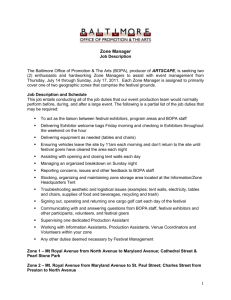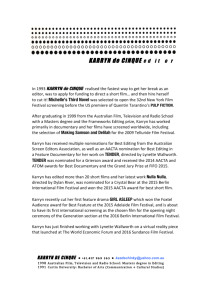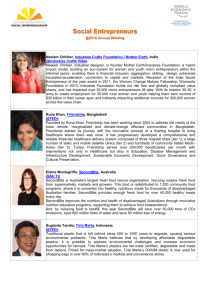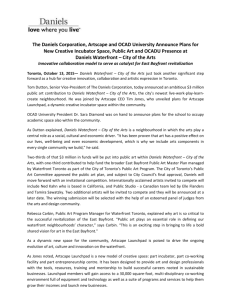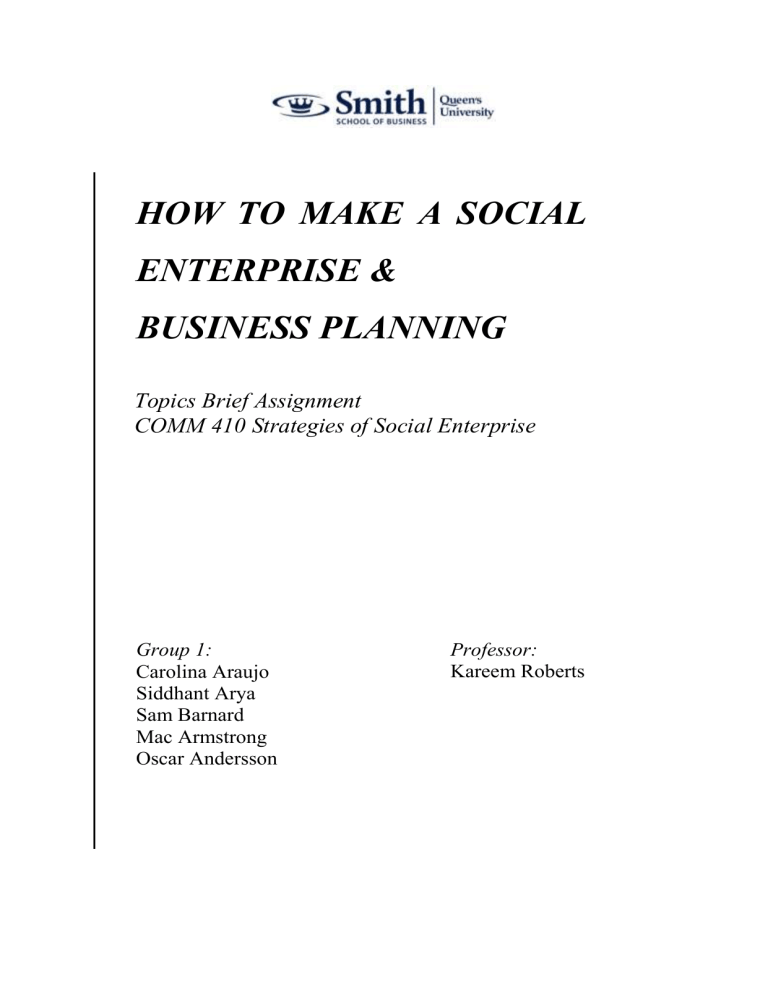
HOW TO MAKE A SOCIAL ENTERPRISE & BUSINESS PLANNING Topics Brief Assignment COMM 410 Strategies of Social Enterprise Group 1: Carolina Araujo Siddhant Arya Sam Barnard Mac Armstrong Oscar Andersson Professor: Kareem Roberts COMM 410 Strategies of Social Enterprise September 19, 2022 Table of Contents INTRODUCTION .......................................................................................................................................... 1 STEPS TO START A SOCIAL ENTERPRISE ............................................................................................ 1 1. 2. 3. 4. 5. ARTICULATE A SOCIAL PROBLEM .............................................................................................................. 1 SURROUND YOURSELF WITH THE APPROPRIATE TEAM ............................................................................... 2 ESTABLISH A SOLID BUSINESS PLAN .......................................................................................................... 2 MARKET EFFECTIVELY TO DRAW IN INVESTORS ........................................................................................ 3 MEASURE YOUR IMPACT ........................................................................................................................... 3 REAL-WORLD EXAMPLE: ARTSCAPE ................................................................................................... 3 SOCIAL ISSUE ...................................................................................................................................................... 4 FUNDING ............................................................................................................................................................ 4 BUSINESS PLAN .................................................................................................................................................. 4 STRATEGIC OBJECTIVES ..................................................................................................................................... 5 ARTSCAPE’S PLAN .............................................................................................................................................. 5 OUTCOMES ......................................................................................................................................................... 5 CONCLUSION............................................................................................................................................... 5 REFERENCES ............................................................................................................................................... 6 Introduction The concept of a social enterprise was originally developed to challenge the traditional corporate culture that focused on maximizing profits and minimizing costs. It has since emerged as a not-for-profit project where all revenue generated is reinvested into the organization so that it can keep changing to meet current challenges. The funding for social enterprises primarily consists of investments, grants, and fundraising endeavours. Nowadays there are several ways to choose how to organize a social enterprise and various issues in the world that need to be addressed. There is no right way to manage a social enterprise since the solution to every challenge is individually tailored for each company. However, there are five general steps to take into consideration: Steps to start a social enterprise 1. Articulate a social problem Firstly, it’s essential to find a social issue that can be addressed (and hopefully one that resonates deeply with the founders!). It is also crucial that a revenue stream can be developed 1 in the process of building the social enterprise. There are some social problems that need to be addressed but don’t necessarily allow profit generation at long term, preventing the success of the enterprise. Hence, both elements need to be thought out properly before proceeding. 2. Surround yourself with the appropriate team Having a team that is not only invested in the cause but also an expert in the field is essential to the company’s success. A group of diverse people allows you to get a global viewpoint: for example, people from different backgrounds, work experience, and skillsets bring with them different knowledge and experiences. Hiring staff with a collective goal and similar values, and always communicating honestly and clearly, is indispensable in establishing a good culture within the organization. The consequent benefits include lower turnover rates, higher employer satisfaction, increased innovation, and better employee work ethic. 3. Establish a solid business plan A business plan is a document describing a company's core activities and how it plans to achieve its goals. It essentially consolidates and formalises the previous planning and thinking done into a document. In the context of a social enterprise, this document can be used to attract investors and get an idea set in motion. Furthermore, they can be used by all companies as an internal guide to keep an executive team focused on and working toward short- and long-term objectives. It should be noted that a business plan is not a static document; it is considered ‘living’ as it evolves with the business. As an enterprise grows and changes, so too should its’ business plan, so company board’s usually have an annual review to update their plan, based on successes, setbacks, and other new information. Although the elements of every business plan vary, they typically should include the goals, structure/hierarchy, and sections on their products and services, marketing strategy and analysis (e.g., SWOT analysis), financial planning, and a budget. 2 An important consideration when creating a document like this is to have accurate assumptions when making financial projects, or else cash flow shortages or restrictive budgets may pose a problem down the line. Another consideration is that some flexibility must be built into your plan, as market demand and economic situations constantly fluctuate, so both the company staff and external stakeholders need to know that there are some precautions that have already been implemented so that an enterprise can pivot if need be. 4. Market effectively to draw in investors Decide on how to finance your endeavour: this can be publicly, through fundraising, or through private channels instead, such as investors. Choosing the best method usually requires an appropriated analysis of markets, competitors, and audience. Hence, the enterprise must start by finding the right marketing strategy to reach the total addressable market (TAM), and then create material that best represents its purpose and goal. This could be by using its’ business plan to discuss gaining funds from investors, or by using crowdfunding, charity events, incubators, etc., to secure grants from others who believe in your social mission and want to contribute to the company’s success. Either way, communicating the urgency of your issue and the novelty of your solution is key to developing your enterprise further. 5. Measure your impact Once the social enterprise can operate, shareholders and stakeholders will constantly monitor its progress. Developing KPIs (key performance indicators) is fundamental since they help you understand the performance of the company. These indicators can measure anything, from finances, employees' productivity, the efficiency of PPE (personal protective equipment), etc. Investors will need proof that their investment is making a difference, and these KPIs will highlight that, building more confidence for the firm and hopefully leading to more funding. Real-World Example: Artscape Artscape, a non-profit organization, is a real-world example of a social enterprise. This company with artists, community leaders, public policy advocates, and urban developers, with the mission to make space for creativity and to transform communities. The core of its work 3 focuses on developing real estate projects, programs, and services to empower artists and better connect them with society. Social issue In 1986, Toronto’s real estate market was booming, and the city was cracking down on illegal artist workspaces without any health and safety concerns. Artscape was founded of the need to address this challenge. Funding The early success of Artscape was marked by a commitment of operational funding by the City of Toronto and a collaboration with Toronto Economic Development Corporation. This funding allowed the creation of its first artist studio project at 60 Atlantic Avenue in Liberty Village, in 1898. Business Plan Artscape was born with a clear mission: making space for creativity and transforms communities. Their first business plan, Artscape 1.0 (1986-1990), focused on conducting research and building a relationship with the City of Toronto. Key accomplishments during this period included, for example, the publication of No Vacancy, a report that related challenges facing Toronto artists and art organizations. Over more than thirty years, Artscape has evolved from a Toronto-based affordable artist studio provider to a global leader in creative placemaking. In the beginning of 2018, Artscape understood there were some challenges that artists were going through, mainly: Affordability crisis (e.g.: lack of affordable space for artists); and Precarious work (e.g.: their incomes were often supplemented by low-wage service jobs). Consequently, the struggle to sustain a career as an artist was intensified. With this said, let’s investigate Artscape 5.0 (2018-2022) – Artscape’ strategic plan developed to face those challenges. 4 Strategic Objectives Based on their background and mission, Artscape 5.0 was able to define its own major strategic objectives: Cultivate thriving communities; Serve more people and communities; Build organizational resilience. Artscape’s Plan After an appropriated analysis of markets as well as competitors, Artscape was able to decide how to make its objectives become real. At this point, the enterprise selected its business’ services, decided their marketing and sales strategies and, finally, implemented Artscape 5.0. Some of the main features of this business plan were: Expand programs and services; Develop new projects primarily in Toronto; Build a creative placemaking knowledge locally/globally (e.g.: Artscape Daniels Launchpad – a new hub for art and design entrepreneurship scheduled that opened in the Fall of 2018). Outcomes Finally, by establishing and monitoring its quantifiable financial/mission goals, and defining a financial plan, Artscape 5.0 presented clear and realistic projections for its outcomes, for example: Tenants, members, owners, and clients of Artscape’s facilities, programs and services will grow from 2,700 to 10,000; Artscape's Toronto-area facilities will grow from 11 to 18; Volunteer and staff satisfaction of 74% in 2017 will be improved. Conclusion Social enterprises give entrepreneurs the opportunity to run a healthy organization that has a positive impact on society. However, the work also involves some challenges that must be considered to achieve the best possible result. The company must have a strong foundation of competence and knowledge so that it can appropriately distribute revenue to the social projects that it hopes to address. A business plan will therefore be of utmost importance for the company to have a functioning structure and clear objectives. There must also be mechanisms to measure its’ impact on society, usually using KPIs (key performance indicators). These indicators can also serve as proof for investors or contributors, which can be a large part of a social enterprise's source of income. Finally, it is important to be able to analyse a company’s development and performance, so that it can make changes as required and continue to evolve. 5 References https://www.investopedia.com/terms/b/business-plan.asp https://www.propelnonprofits.org/wpcontent/uploads/2017/10/social_enterprise_business_plan_Propel.pdf https://www.growthink.com/businessplan/help-center/social-enterprise-business-plan https://www.artscape.ca/about-us/evolution/ https://www.artscape.ca/wp-content/uploads/2017/10/Artscape-Strategic-Plan-2018-to2022.pdf 6



